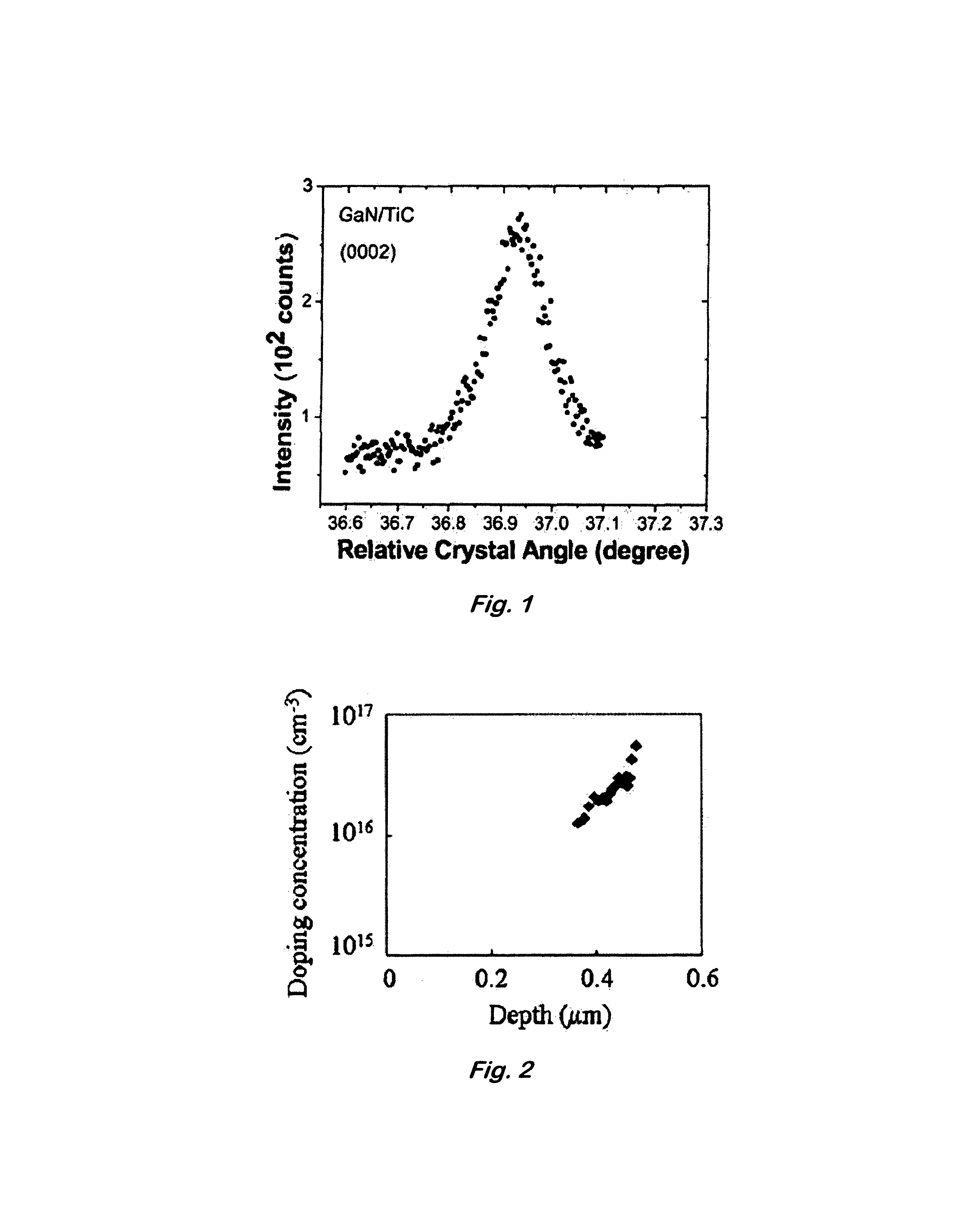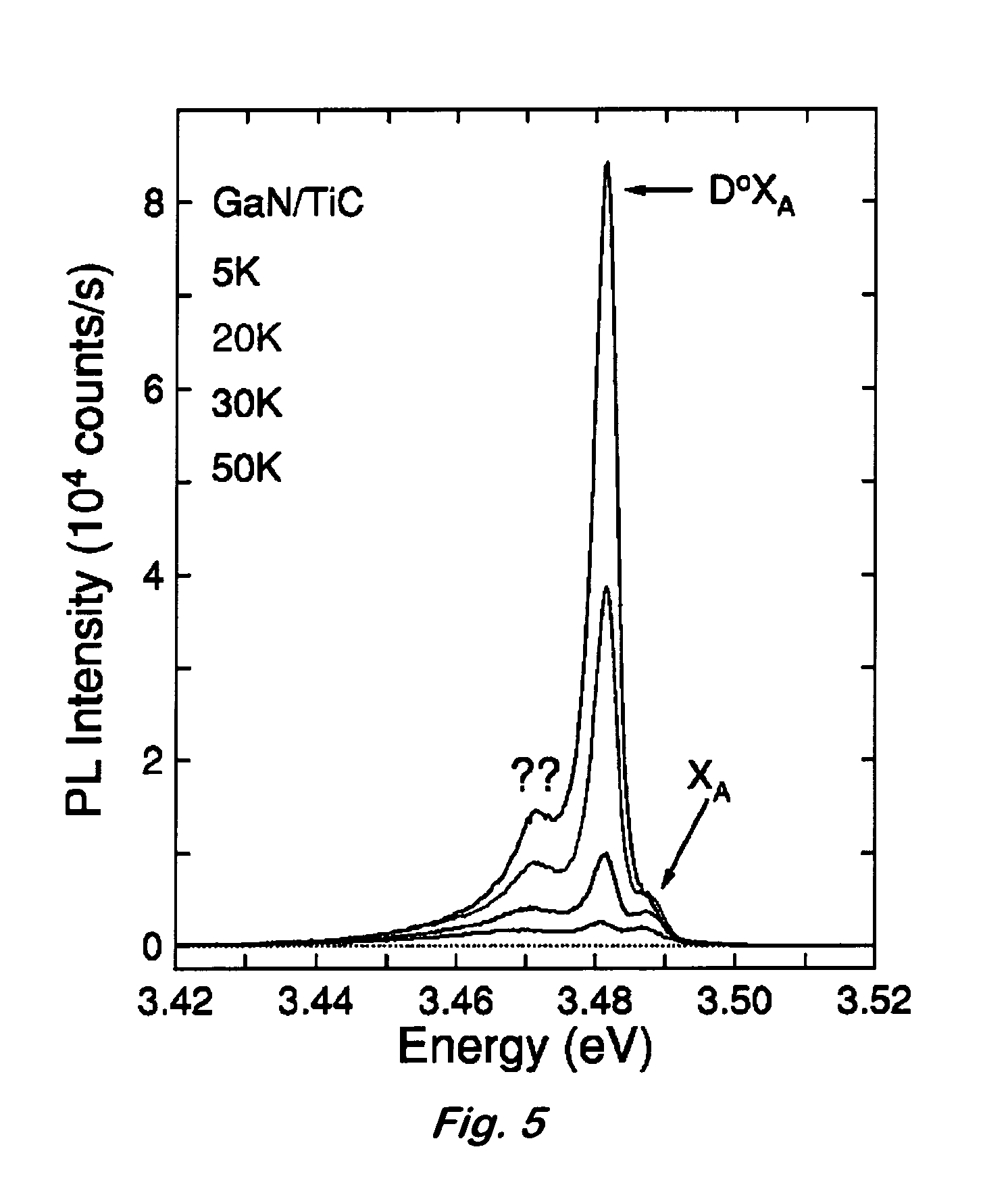Crystalline III-V nitride films on refractory metal substrates
a technology of metal nitride and crystalline iii-v, which is applied in the direction of basic electric elements, electrical equipment, semiconductor devices, etc., can solve the problems of large lattice and thermal mismatch of materials
- Summary
- Abstract
- Description
- Claims
- Application Information
AI Technical Summary
Benefits of technology
Problems solved by technology
Method used
Image
Examples
example 1
[0030]General procedure—Titanium carbide substrates were loaded into a reactor for the epitaxial growth of gallium nitride or its alloys. Organometallic vapor phase epitaxy was used for this growth. Titanium carbide substrates were heated for a cleaning step up to 1350° C. for 3 min, then cooled down to 450° C. for growth of the nucleation layer. While aluminum nitride was utilized for the nucleation layer, a gallium nitride or alloyed aluminum / gallium / indium nitride nucleation layer can be used with the same resultant effect. Triethylaluminum (200 sccm flowed through a source at 1000 torr at a constant temperature of 30° C.) and 2.5 SLM (standard liters per minute) ammonia were used as reactants in 3.5 SLM hydrogen carrier gas. Following formation of the nucleation layer, which took approximately 13 min, the temperature was raised to 1000° C. over a period of 5 min. Once 1000° C. was reached, gallium nitride growth was commenced. Trimethylgallium (20 sccm flowed through a source at...
example 2
[0031]The TiC substrates used were grown by a high-pressure float-zone method (Parsons et al., Solid State Technol., 11, 133 (1990)). Epitaxial gallium nitride films of about 3.0 μm thickness were grown on both TiC (100) and (111) substrates by low-pressure organometallic vapor phase epitaxy (LP-OMVPE) in a vertical reactor geometry at 57 Torr. The surface of substrates 5 mm square and ˜1 mm in thickness were solvent-cleaned and heated to 1350° C. in H2 for 5 min prior to growth. Nucleation layers of AlN with 15 mm of thickness were then grown at 450° C. using triethylaluminum, ammonia, and hydrogen. AlN was used as the nucleation layer because its atomic spacing is intermediate to TiC and GaN and 1.5% mismatched to TiC. GaN films were then grown at 1000° C. using trimethylgallium, ammonia, and hydrogen. Films with a root-mean-square (rms) roughness of 0.55 nm (1×1 μm area) as determined by atomic force microscopy (AFM) were deposited. Submicrometer size pores, typically observed in...
example 3
[0035]Substrates of (100) and (111) TiC, 5 mm square and ˜1.0 mm thick, were loaded into an organometallic vapor phase epitaxy reactor for the GaN epitaxial growth. TiC substrates were heated in hydrogen at 1350° C. for 3 min, then cooled down to 450° C. for growth of a nucleation layer. Aluminum nitride was utilized for the nucleation layer. A GaN or alloyed AlInGaN nucleation layer can also be used with the same result. Triethylaluminum (1.5×10−4 mol / min) and 2.5 SLM (standard liters per minute) ammonia were used as reactants in 3.5 SLM hydrogen carrier gas. Following formation of the nucleation layer, which took approximately 13 min, the temperature was raised to 1000° C. over a period of 5 min. Once 1000° C. was reached, GaN growth commenced. Trimethylgallium (4.1×10−5 mol / min) and 2.5 SLM ammonia were used as reactants in 3.5 SLM hydrogen carrier gas. Growth of the GaN took place for 85 min. All growth was carried out at a total pressure of 57 torr. Samples were cooled in 2.5 S...
PUM
| Property | Measurement | Unit |
|---|---|---|
| temperature | aaaaa | aaaaa |
| temperature | aaaaa | aaaaa |
| temperature | aaaaa | aaaaa |
Abstract
Description
Claims
Application Information
 Login to View More
Login to View More - Generate Ideas
- Intellectual Property
- Life Sciences
- Materials
- Tech Scout
- Unparalleled Data Quality
- Higher Quality Content
- 60% Fewer Hallucinations
Browse by: Latest US Patents, China's latest patents, Technical Efficacy Thesaurus, Application Domain, Technology Topic, Popular Technical Reports.
© 2025 PatSnap. All rights reserved.Legal|Privacy policy|Modern Slavery Act Transparency Statement|Sitemap|About US| Contact US: help@patsnap.com



